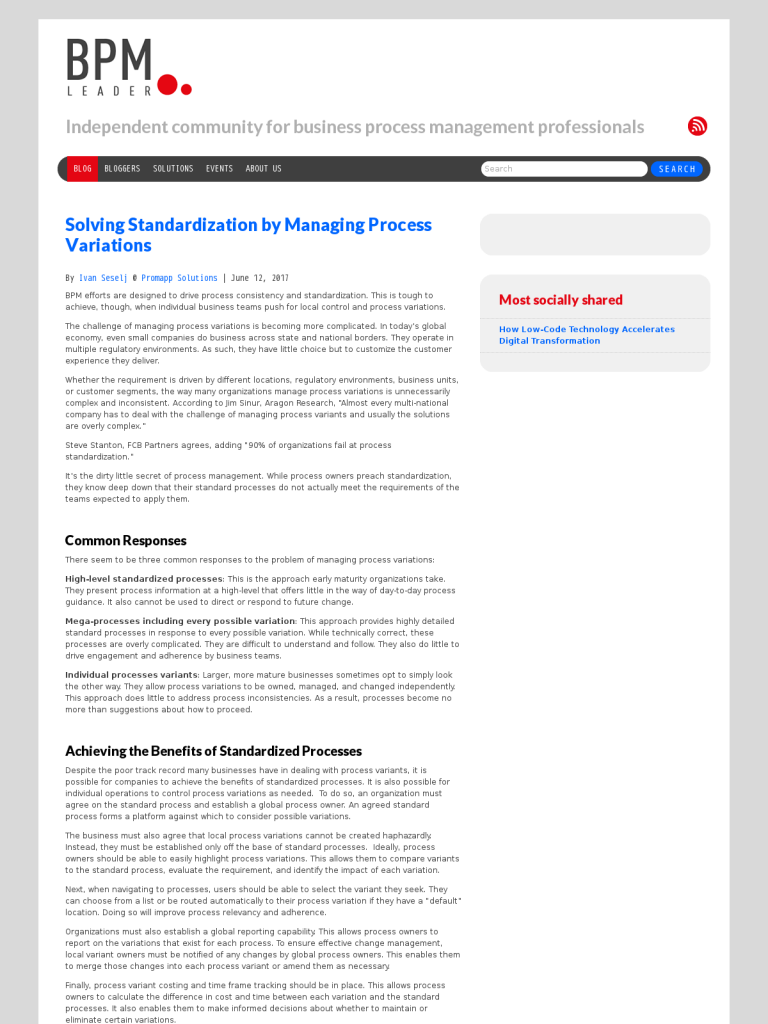Solving Standardization by Managing Process Variations
Blog: BPM Leader
BPM efforts are designed to drive process consistency and standardization. This is tough to achieve, though, when individual business teams push for local control and process variations.
The challenge of managing process variations is becoming more complicated. In today’s global economy, even small companies do business across state and national borders. They operate in multiple regulatory environments. As such, they have little choice but to customize the customer experience they deliver.
Whether the requirement is driven by different locations, regulatory environments, business units, or customer segments, the way many organizations manage process variations is unnecessarily complex and inconsistent. According to Jim Sinur, Aragon Research, “Almost every multi-national company has to deal with the challenge of managing process variants and usually the solutions are overly complex.”
Steve Stanton, FCB Partners agrees, adding “90% of organizations fail at process standardization.”
It’s the dirty little secret of process management. While process owners preach standardization, they know deep down that their standard processes do not actually meet the requirements of the teams expected to apply them.
Common Responses
There seem to be three common responses to the problem of managing process variations:
High-level standardized processes: This is the approach early maturity organizations take. They present process information at a high-level that offers little in the way of day-to-day process guidance. It also cannot be used to direct or respond to future change.
Mega-processes including every possible variation: This approach provides highly detailed standard processes in response to every possible variation. While technically correct, these processes are overly complicated. They are difficult to understand and follow. They also do little to drive engagement and adherence by business teams.
Individual processes variants: Larger, more mature businesses sometimes opt to simply look the other way. They allow process variations to be owned, managed, and changed independently. This approach does little to address process inconsistencies. As a result, processes become no more than suggestions about how to proceed.
Achieving the Benefits of Standardized Processes
Despite the poor track record many businesses have in dealing with process variants, it is possible for companies to achieve the benefits of standardized processes. It is also possible for individual operations to control process variations as needed. To do so, an organization must agree on the standard process and establish a global process owner. An agreed standard process forms a platform against which to consider possible variations.
The business must also agree that local process variations cannot be created haphazardly. Instead, they must be established only off the base of standard processes. Ideally, process owners should be able to easily highlight process variations. This allows them to compare variants to the standard process, evaluate the requirement, and identify the impact of each variation.
Next, when navigating to processes, users should be able to select the variant they seek. They can choose from a list or be routed automatically to their process variation if they have a “default” location. Doing so will improve process relevancy and adherence.
Organizations must also establish a global reporting capability. This allows process owners to report on the variations that exist for each process. To ensure effective change management, local variant owners must be notified of any changes by global process owners. This enables them to merge those changes into each process variant or amend them as necessary.
Finally, process variant costing and time frame tracking should be in place. This allows process owners to calculate the difference in cost and time between each variation and the standard processes. It also enables them to make informed decisions about whether to maintain or eliminate certain variations.
Although it can be challenging, effectively managing and controlling process variations is possible. Employing these steps helps businesses to understand the extent of the process variations they are managing. They can control and report on them. They can challenge them if necessary. They also empower teams to be more agile, more flexible, and more able to customize activities because variations will exist in an environment over which they have clarity and control.
The post Solving Standardization by Managing Process Variations appeared first on BPM Leader.
Leave a Comment
You must be logged in to post a comment.








